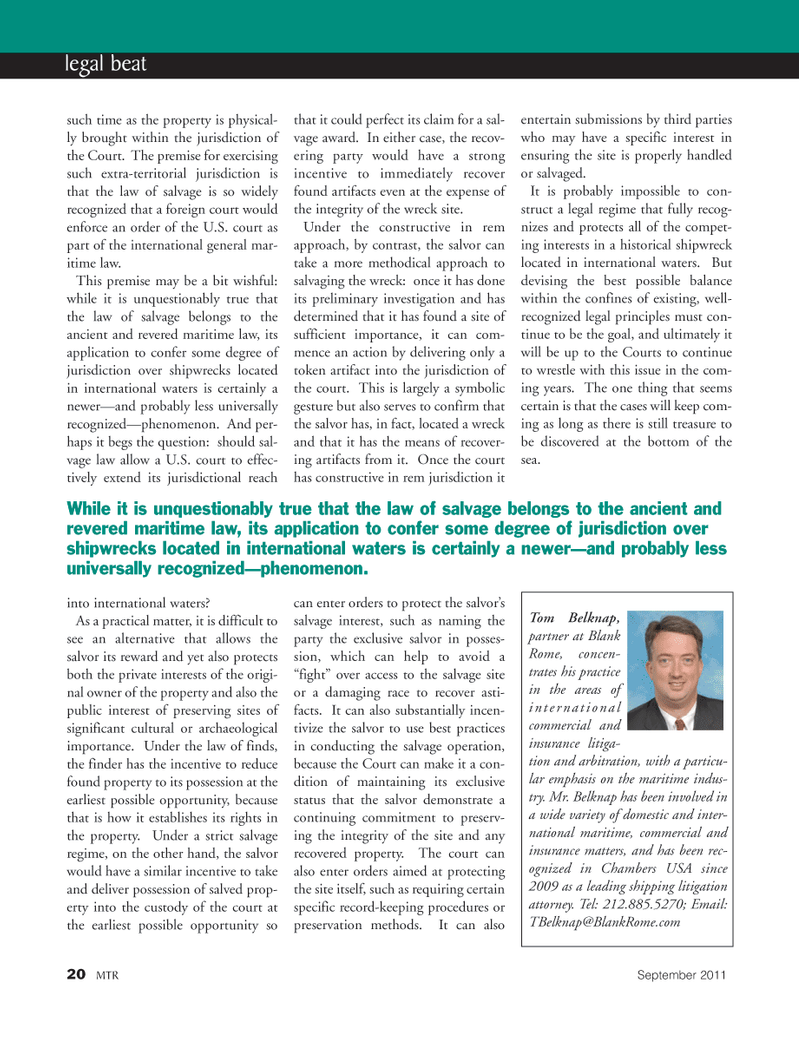
Page 20: of Marine Technology Magazine (September 2011)
Ocean Observation
Read this page in Pdf, Flash or Html5 edition of September 2011 Marine Technology Magazine
such time as the property is physical- ly brought within the jurisdiction of the Court. The premise for exercising such extra-territorial jurisdiction isthat the law of salvage is so widely recognized that a foreign court would enforce an order of the U.S. court as part of the international general mar- itime law. This premise may be a bit wishful: while it is unquestionably true that the law of salvage belongs to the ancient and revered maritime law, its application to confer some degree of jurisdiction over shipwrecks located in international waters is certainly a newer?and probably less universally recognized?phenomenon. And per- haps it begs the question: should sal-vage law allow a U.S. court to effec- tively extend its jurisdictional reach into international waters?As a practical matter, it is difficult to see an alternative that allows the salvor its reward and yet also protects both the private interests of the origi- nal owner of the property and also the public interest of preserving sites of significant cultural or archaeological importance. Under the law of finds, the finder has the incentive to reduce found property to its possession at the earliest possible opportunity, because that is how it establishes its rights in the property. Under a strict salvage regime, on the other hand, the salvor would have a similar incentive to take and deliver possession of salved prop- erty into the custody of the court at the earliest possible opportunity so that it could perfect its claim for a sal- vage award. In either case, the recov- ering party would have a strong incentive to immediately recover found artifacts even at the expense of the integrity of the wreck site. Under the constructive in rem approach, by contrast, the salvor can take a more methodical approach to salvaging the wreck: once it has done its preliminary investigation and has determined that it has found a site ofsufficient importance, it can com- mence an action by delivering only a token artifact into the jurisdiction of the court. This is largely a symbolic gesture but also serves to confirm that the salvor has, in fact, located a wreck and that it has the means of recover- ing artifacts from it. Once the court has constructive in rem jurisdiction it can enter orders to protect the salvor?s salvage interest, such as naming the party the exclusive salvor in posses- sion, which can help to avoid a ?fight? over access to the salvage site or a damaging race to recover asti- facts. It can also substantially incen- tivize the salvor to use best practices in conducting the salvage operation, because the Court can make it a con- dition of maintaining its exclusive status that the salvor demonstrate a continuing commitment to preserv- ing the integrity of the site and anyrecovered property. The court can also enter orders aimed at protecting the site itself, such as requiring certain specific record-keeping procedures or preservation methods. It can also entertain submissions by third parties who may have a specific interest in ensuring the site is properly handled or salvaged. It is probably impossible to con- struct a legal regime that fully recog- nizes and protects all of the compet- ing interests in a historical shipwreck located in international waters. But devising the best possible balancewithin the confines of existing, well- recognized legal principles must con- tinue to be the goal, and ultimately itwill be up to the Courts to continue to wrestle with this issue in the com- ing years. The one thing that seems certain is that the cases will keep com- ing as long as there is still treasure to be discovered at the bottom of the sea.20MTRSeptember2011 Tom Belknap, partner at Blank Rome, concen- trates his practice in the areas of international commercial and insurance litiga- tion and arbitration, with a particu- lar emphasis on the maritime indus-try. Mr. Belknap has been involved in a wide variety of domestic and inter- national maritime, commercial and insurance matters, and has been rec- ognized in Chambers USA since 2009 as a leading shipping litigationattorney. Tel: 212.885.5270; Email: [email protected] While it is unquestionably true that the law of salvage belongs to the ancient andrevered maritime law, its application to confer some degree of jurisdiction over shipwrecks located in international waters is certainly a newer?and probably less universally recognized?phenomenon. legal beatMTR#7 (18-33):MTR Layouts 8/29/2011 9:42 AM Page 20

 19
19

 21
21
